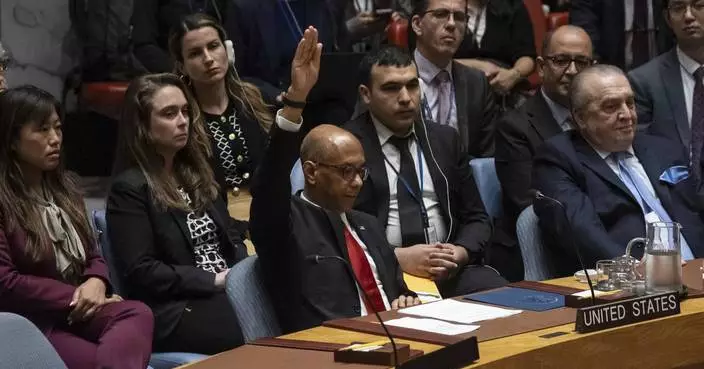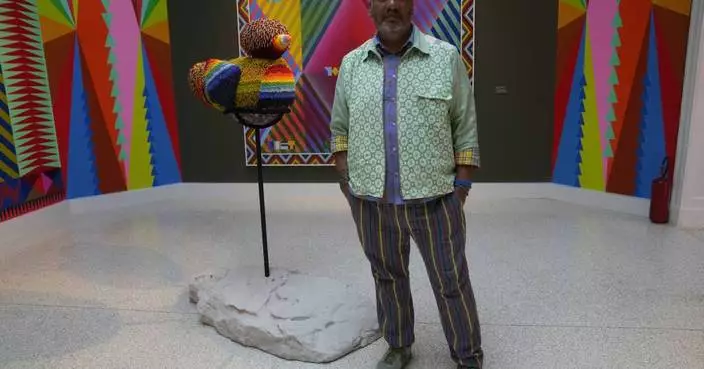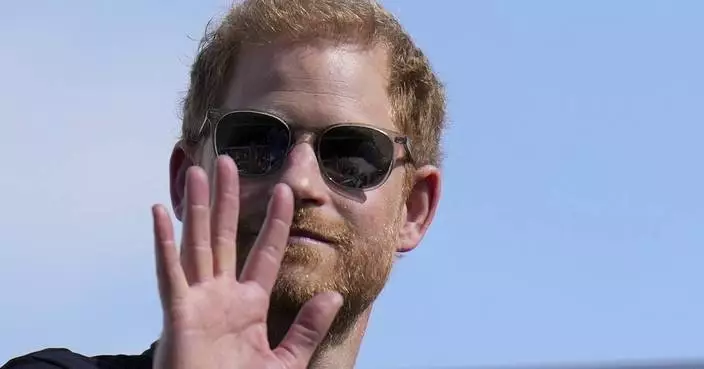The "Making a Murderer" filmmakers were in many ways in a race against the clock to make part two of their documentary series, now available on Netflix.
"We were in post-production from day one," said Moira Demos. "We were shooting and editing and shooting and editing and finding the story as we went."
The first "Making a Murderer" recounted the story of Steven Avery and his nephew, Brendan Dassey, who were convicted in the 2005 slaying of Wisconsin photographer Teresa Halbach. Avery and Dassey are serving life sentences in the killing.
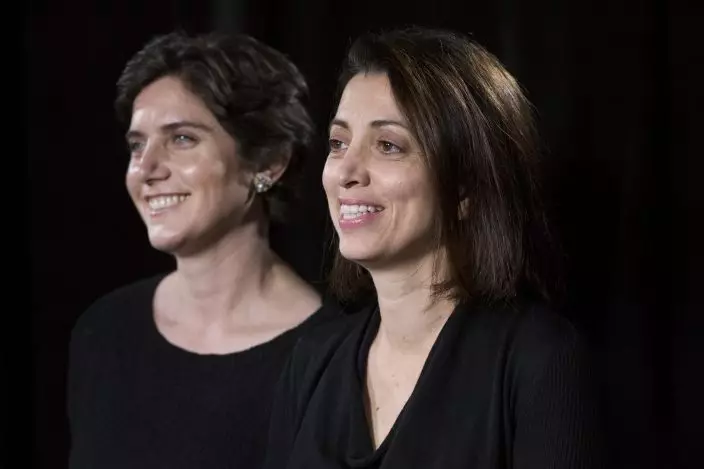
Filmmakers Moira Demos, left, and Laura Ricciardi talk during an interview, Friday, Oct. 19, 2018, in New York. The second season of their Netflix series "Making a Murderer" premieres on Friday. (AP PhotoMark Lennihan)
Filming for the second season stopped in July and Demos and her co-director, Laura Ricciardi, only handed in the finished product to Netflix a few weeks ago.
Much of what viewers will see in this new season is Steven Avery's attorney, Kathleen Zellner, go over the entire case with a fine tooth comb to piece together what may have happened to Halbach. She's meticulous with details and has multiple experts test various theories.
In an interview with The Associated Press, the filmmakers talked about how they handled the attention on their work, criticism from some viewers and what they hope ultimately will come from the series.
AP: Was it hard to cover the continuation of this story, when "Making a Murderer" became a part of the story?
Demos: The attention on the case didn't really affect our process because for part two, in a lot of ways, it's the inverse of part one. We're in the courtroom for four solid episodes of part one and what's going on in part two is these legal teams are fighting to just get into court. They would love to be in court to be arguing against the other side about the evidence but that's not a guarantee. So there's a lot of behind the scenes, there's a lot of preparation, there's a lot of investigation and a lot of that is happening on private property or our filming with the family is on private property, so you know we weren't so much in the spotlight. We weren't out in public.
AP: Season one made such an impact that Ken Kratz (the former district attorney of Calumet county, Wisconsin, who prosecuted Avery and Dassey) and others received death threats. What do you say to that?
Ricciardi: It's obviously disappointing to hear negative or threatening or potentially violent reactions or responses that people had. .. Obviously we have no control over how people respond. To the extent that we hoped viewers would be engaged and perhaps have a passionate response, we were hoping that that response would be good. So there are lots of people who now recognize that there are flaws in the system. There's room for improvement so it would be nice if we focused on potential reforms or just keeping the dialogue going.
AP: Some critics say that your narrative is one-sided and biased. What do you say to that?
Demos: Our point of view isn't in the series. We have a collection of subjects and characters with all different points of view. .. It's Steven Avery's journey that we're on. We're documenting the subjective experience of Steven. (Note: At the end of each episode there is a card on the screen listing at least 70 people who didn't respond or declined to be interviewed in the series. Those names include Halbach's family members and Kratz.)
Online: https://www.netflix.com/title/80000770
Follow Alicia Rancilio online at http://www.twitter.com/aliciar
TOKYO (AP) — The American envoy to the United Nations called Friday for countries armed with atomic weapons to pursue nuclear disarmament as she visited the atomic bomb museum in Nagasaki, Japan.
Linda Thomas-Greenfield, who became the first U.S. cabinet member to visit Nagasaki, stressed the importance of dialogue and diplomacy amid a growing nuclear threat in the region.
“We must continue to work together to create an environment for nuclear disarmament. We must continue to prevent the spread of nuclear weapons in every corner of the world,” she said after a tour of the atomic bomb museum.
“For those of us who already have those weapons, we must pursue arms control. We can and must work to ensure that Nagasaki is the last place to ever experience the horror of nuclear weapons,” she added, standing in front of colorful hanging origami cranes, a symbol of peace.
The United States dropped the world’s first atomic bomb on Hiroshima on Aug. 6, 1945, destroying the city and killing 140,000 people. A second attack three days later on Nagasaki killed 70,000 more people. Japan surrendered on Aug. 15, ending World War II and its nearly half-century of aggression in Asia.
Nagasaki Gov. Kengo Oishi said in a statement that he believed Thomas-Greenfield's visit and her first-person experience at the museum “will be a strong message in promoting momentum of nuclear disarmament for the international society at a time the world faces a severe environment surrounding atomic weapons.”
Oishi said he conveyed to the ambassador the increasingly important role of Nagasaki and Hiroshima in emphasizing the need of nuclear disarmament.
Thomas-Greenfield's visit to Japan comes on the heels of Prime Minister Fumio Kishida's official visit to the United States last week and is aimed at deepening Washington's trilateral ties with Tokyo and Seoul. During her visit to South Korea earlier this week, she held talks with South Korean officials, met with defectors from North Korea and visited the demilitarized zone.
The ambassador said the United States is looking into setting up a new mechanism for monitoring North Korea's nuclear weapons program. Russia and China have thwarted U.S.-led efforts to step up U.N. sanctions on North Korea over its ballistic missile testing since 2022, underscoring a deepening divide between permanent Security Council members over Russia’s war on Ukraine.
She said it would be “optimal” to launch the new system next month, though it is uncertain if that is possible.
The U.N. Security Council established a committee to monitor sanctions, and the mandate for its panel of experts to investigate violations had been renewed for 14 years until last month, when Russia vetoed another renewal.
In its most recent report, the panel of experts said it is investigating 58 suspected North Korean cyberattacks between 2017 and 2023 valued at approximately $3 billion, with the money reportedly being used to help fund its weapons development.
The United States, Japan and South Korea have been deepening security ties amid growing tension in the region from North Korea and China.
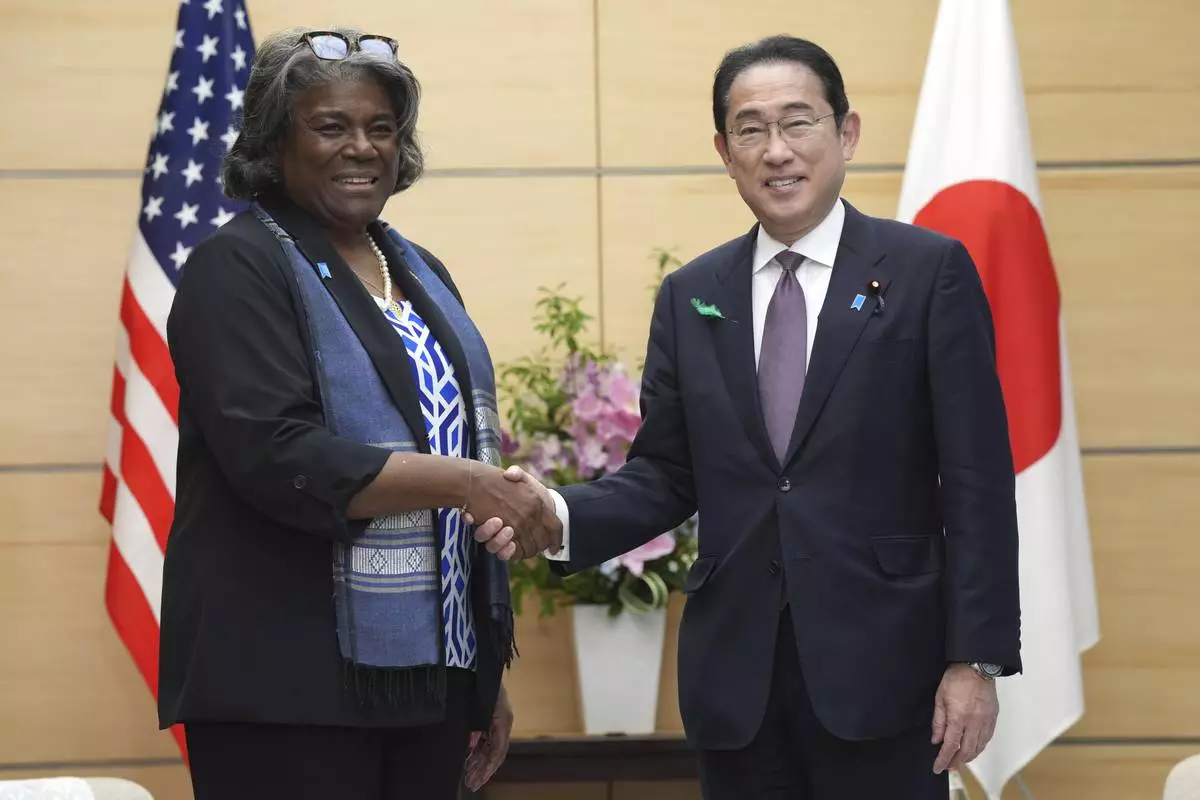
U.S. Ambassador to United Nations Linda Thomas-Greenfield, left, and Japan's Prime Minister Fumio Kishida, right, shake hands during a meeting Friday, April 19, 2024, at prime minister's office in Tokyo. (AP Photo/Eugene Hoshiko, Pool)

U.S. Ambassador to United Nations Linda Thomas-Greenfield, left, and Japan's Prime Minister Fumio Kishida, right, shake hands during a meeting Friday, April 19, 2024, at prime minister's office in Tokyo. (AP Photo/Eugene Hoshiko, Pool)
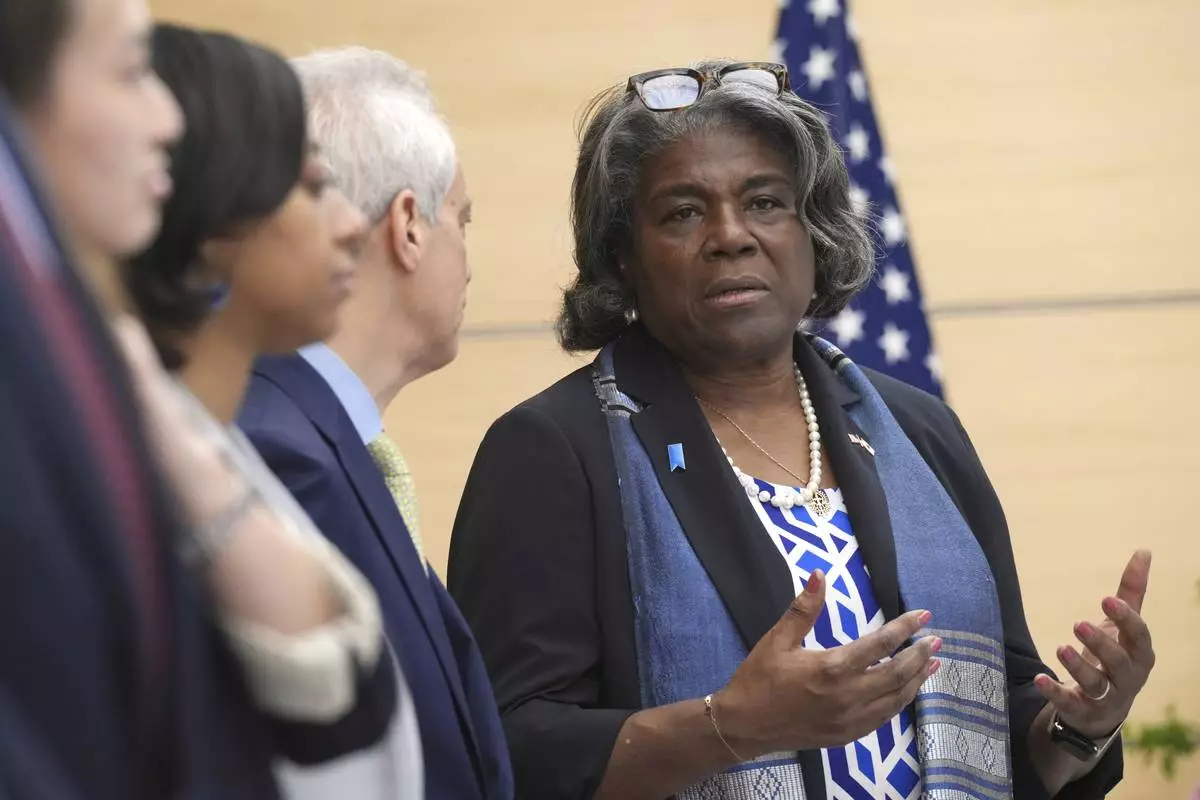
U.S. Ambassador to United Nations Linda Thomas-Greenfield, right, speaks to Rahm Emanuel, U.S. Ambassador to Japan, second right, as they wait for a meeting with Japan's Prime Minister Fumio Kishida Friday, April 19, 2024, at prime minister's office in Tokyo. (AP Photo/Eugene Hoshiko, Pool)
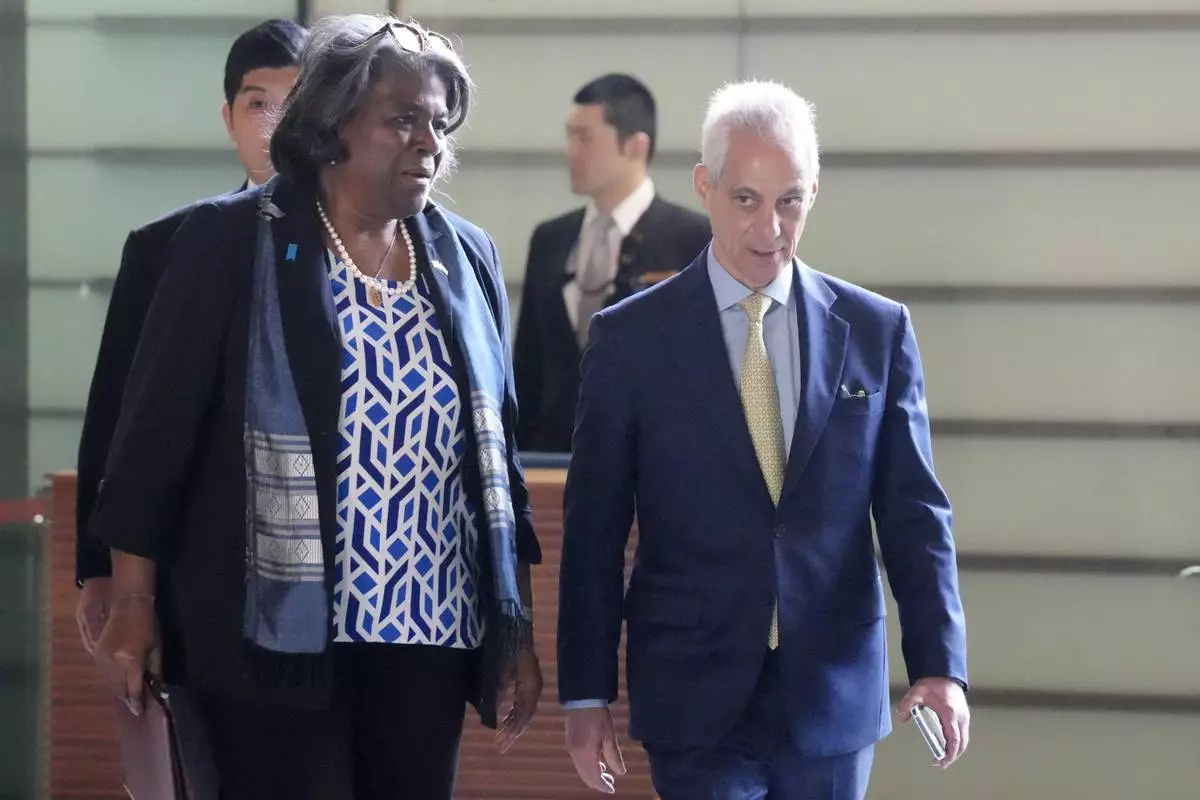
U.S. Ambassador to United Nations Linda Thomas-Greenfield, left, and Rahm Emanuel, U.S. Ambassador to Japan, right, walk to meet Japan's Prime Minister Fumio Kishida Friday, April 19, 2024, at prime minister's office in Tokyo. (AP Photo/Eugene Hoshiko, Pool)
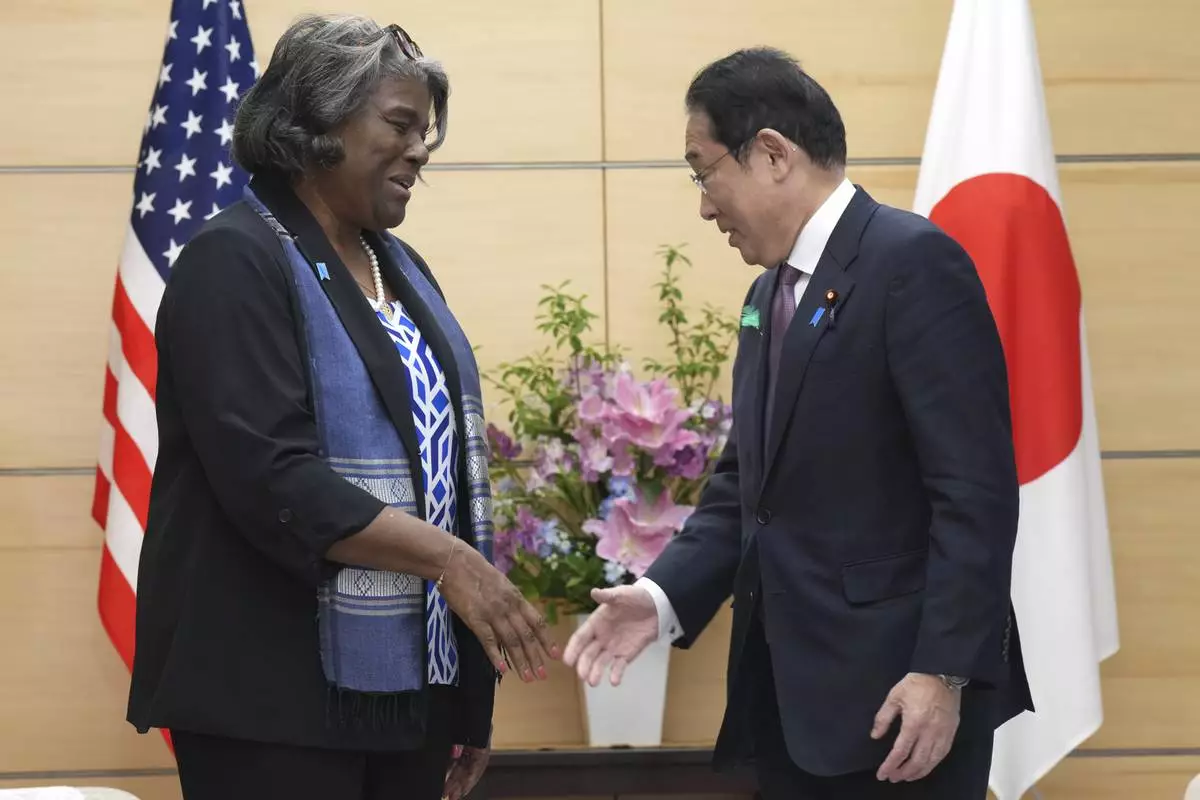
U.S. Ambassador to United Nations Linda Thomas-Greenfield, left, and Japan's Prime Minister Fumio Kishida, right, talk prior to a meeting Friday, April 19, 2024, at prime minister's office in Tokyo. (AP Photo/Eugene Hoshiko, Pool)
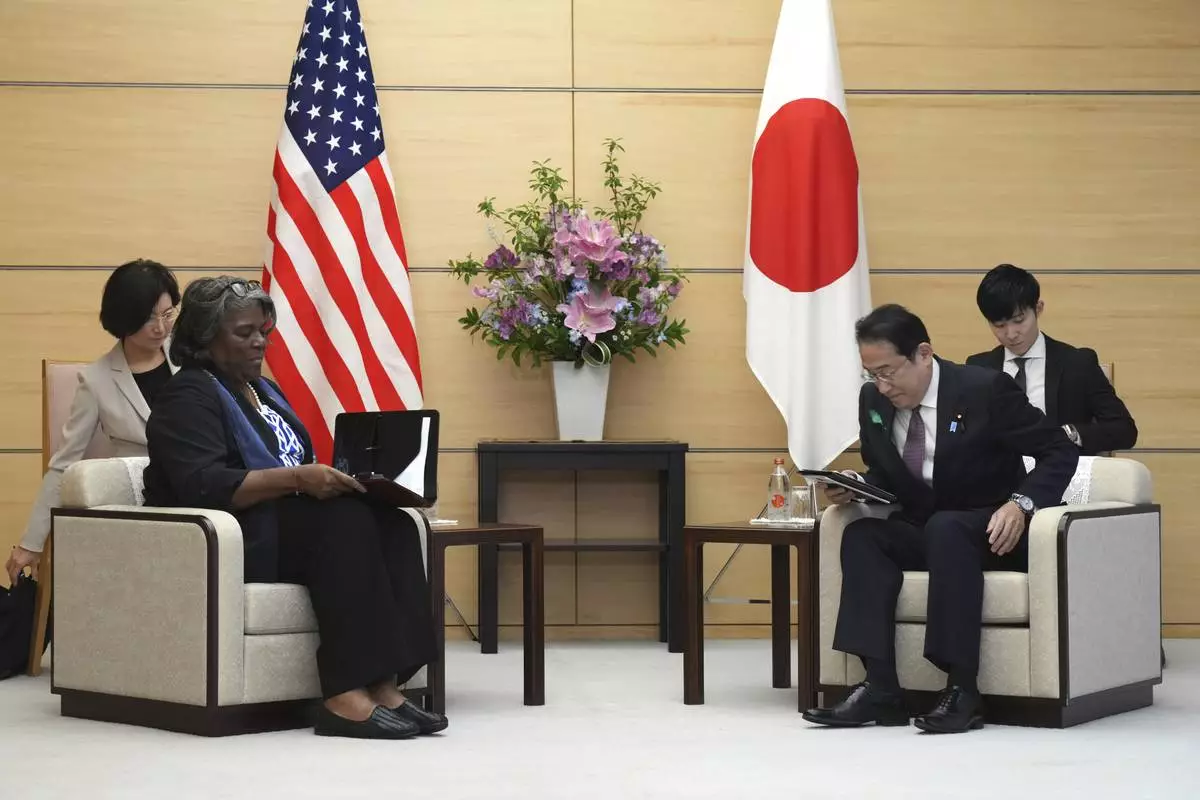
U.S. Ambassador to United Nations Linda Thomas-Greenfield, left, and Japan's Prime Minister Fumio Kishida, right, prepare to talk during a meeting Friday, April 19, 2024, at prime minister's office in Tokyo. (AP Photo/Eugene Hoshiko, Pool)











